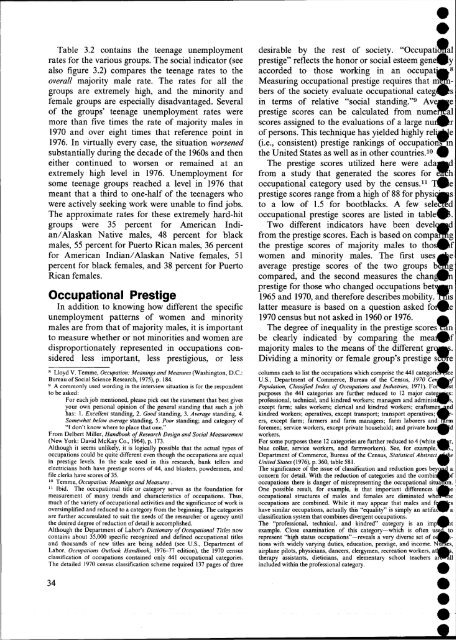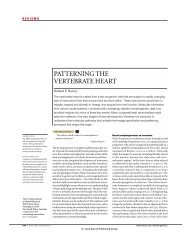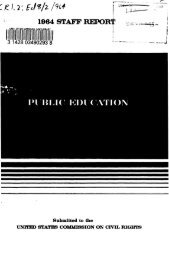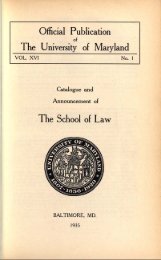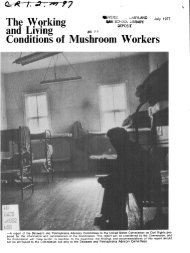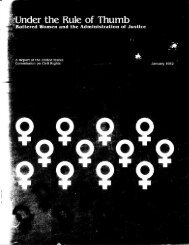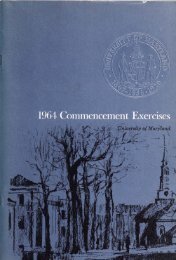Social Indicators of Equality for Minorities and Women - University of ...
Social Indicators of Equality for Minorities and Women - University of ...
Social Indicators of Equality for Minorities and Women - University of ...
- No tags were found...
Create successful ePaper yourself
Turn your PDF publications into a flip-book with our unique Google optimized e-Paper software.
Table 3.2 contains the teenage unemploymentrates <strong>for</strong> the various groups. The social indicator (seealso figure 3.2) compares the teenage rates to theoverall majority male rate. The rates <strong>for</strong> all thegroups are extremely high, <strong>and</strong> the minority <strong>and</strong>female groups are especially disadvantaged. Several<strong>of</strong> the groups' teenage unemployment rates weremore than five times the rate <strong>of</strong> majority males in1970 <strong>and</strong> over eight times that reference point in1976. In virtually every case, the situation worsenedsubstantially during the decade <strong>of</strong> the 1960s <strong>and</strong> theneither continued to worsen or remained at anextremely high level in 1976. Unemployment <strong>for</strong>some teenage groups reached a level in 1976 thatmeant that a third to one-half <strong>of</strong> the teenagers whowere actively seeking work were unable to find jobs.The approximate rates <strong>for</strong> these extremely hard-hitgroups were 35 percent <strong>for</strong> American Indian/AlaskanNative males, 48 percent <strong>for</strong> blackmales, 55 percent <strong>for</strong> Puerto Rican males, 36 percent<strong>for</strong> American Indian/Alaskan Native females, 51percent <strong>for</strong> black females, <strong>and</strong> 38 percent <strong>for</strong> PuertoRican females.Occupational PrestigeIn addition to knowing how different the specificunemployment patterns <strong>of</strong> women <strong>and</strong> minoritymales are from that <strong>of</strong> majority males, it is importantto measure whether or not minorities <strong>and</strong> women aredisproportionately represented in occupations consideredless important, less prestigious, or lesssLloyd V. Temme, Occupation: Meanings <strong>and</strong> Measures (Washington, D.C.:Bureau <strong>of</strong> <strong>Social</strong> Science Research, 1975), p. 184.9 A commonly used wording in the interview situation is <strong>for</strong> the respondentto be asked:For each job mentioned, please pick out the statement that best givesyour own personal opinion <strong>of</strong> the general st<strong>and</strong>ing that such a jobhas: 1. Excellent st<strong>and</strong>ing, 2. Good st<strong>and</strong>ing, 3. Average st<strong>and</strong>ing, 4.Somewhat below average st<strong>and</strong>ing, 5. Poor st<strong>and</strong>ing; <strong>and</strong> category <strong>of</strong>"I don't know where to place that one."From Delbert Miller, H<strong>and</strong>book <strong>of</strong> Research Design <strong>and</strong> <strong>Social</strong> Measurement(New York: David McKay Co., 1964), p. 173.Although it seems unlikely, it is logically possible that the actual types <strong>of</strong>occupations could be quite different even though the occupations are equalin prestige levels. In the scale used in this research, bank tellers <strong>and</strong>electricians both have prestige scores <strong>of</strong> 44, <strong>and</strong> blasters, powdermen, <strong>and</strong>file clerks have scores <strong>of</strong> 35.10 Temme, Occupation: Meanings <strong>and</strong> Measures .11 Ibid. The occupational title or category serves as the foundation <strong>for</strong>measurement <strong>of</strong> many trends <strong>and</strong> characteristics <strong>of</strong> occupations. Thus,much <strong>of</strong> the variety <strong>of</strong> occupational activities <strong>and</strong> the significance <strong>of</strong> work isoversimplified <strong>and</strong> reduced to a category from the beginning. The categoriesare further accumulated to suit the needs <strong>of</strong> the researcher or agency untilthe desired degree <strong>of</strong> reduction <strong>of</strong> detail is accomplished.Although the Department <strong>of</strong> Labor's Dictionary <strong>of</strong> Occupational Titles nowcontains about 35,000 specific recognized <strong>and</strong> defined occupational titles<strong>and</strong> thous<strong>and</strong>s <strong>of</strong> new titles are being added (see U.S., Department <strong>of</strong>Labor, Occupations Outlook H<strong>and</strong>book, 1976-77 edition), the 1970 censusclassification <strong>of</strong> occupations contained only 441 occupational categories.The detailed 1970 census classification scheme required 137 pages <strong>of</strong> threeionadesirable by the rest <strong>of</strong> society. "Occupationalprestige" reflects the honor or social esteem gene^Pyaccorded to those working in an occupatk^8Measuring occupational prestige requires that numbers<strong>of</strong> the society evaluate occupationalin terms <strong>of</strong> relative "social st<strong>and</strong>ing." 9prestige scores can be calculated from numericalscores assigned to the evaluations <strong>of</strong> a large nui^;i<strong>of</strong> persons. This technique has yielded highly relive(i.e., consistent) prestige rankings <strong>of</strong> occupationalthe United States as well as in other countries. 10 %The prestige scores utilized here were ada|from a study that generated the scores <strong>for</strong>occupational category used by the census. 11prestige scores range from a high <strong>of</strong> 88 <strong>for</strong> physicto a low <strong>of</strong> 1.5 <strong>for</strong> bootblacks. A few seleJoccupational prestige scores are listed inTwo different indicators have been devekfrom the prestige scores. Each is based on compsthe prestige scores <strong>of</strong> majority males towomen <strong>and</strong> minority males. The firstaverage prestige scores <strong>of</strong> the two groups b^compared, <strong>and</strong> the second measures the chaprestige <strong>for</strong> those who changed occupations betw«i1965 <strong>and</strong> 1970, <strong>and</strong> there<strong>for</strong>e describes mobility. Wislatter measure is based on a question asked foi1970 census but not asked in 1960 or 1976. AThe degree <strong>of</strong> inequality in the prestige scores^anbe clearly indicated by comparing themajority males to the means <strong>of</strong> the differentDividing a minority or female group's prestige scTTrecolumns each to list the occupations which comprise the 441 categorie^^eeU.S., Department <strong>of</strong> Commerce, Bureau <strong>of</strong> the Census, 1970Population, Classified Index <strong>of</strong> Occupations <strong>and</strong> Industries, 1971). Foi 1purposes the 441 categories are further reduced to 12 major catespr<strong>of</strong>essional, technical, <strong>and</strong> kindred workers; managers <strong>and</strong> administers,except farm; sales workers; clerical <strong>and</strong> kindred workers; craftsmen^nckindred workers; operatives, except transport; transport operatives; ^Brers,except farm; farmers <strong>and</strong> farm managers; farm laborers <strong>and</strong> rarrr<strong>for</strong>emen; service workers, except private household; <strong>and</strong> private houd"workers.For some purposes these 12 categories are further reduced to 4 (white iblue collar, service workers, <strong>and</strong> farmworkers). See, <strong>for</strong> example,'Department <strong>of</strong> Commerce, Bureau <strong>of</strong> the Census, Statistical Abstract AUnited States (1976), p. 360, table 581.iThe significance <strong>of</strong> the issue <strong>of</strong> classification <strong>and</strong> reduction goesconcern <strong>for</strong> detail. With the reduction <strong>of</strong> categories <strong>and</strong> the combinoccupations there is danger <strong>of</strong> misrepresenting the occupational situation.One possible result, <strong>for</strong> example, is that important differences i^fceoccupational structures <strong>of</strong> males <strong>and</strong> females are eliminated whe^^ieoccupations are combined. While it may appear that males <strong>and</strong> <strong>for</strong>teshave similar occupations, actually this "equality" is simply an artifaoHPaclassification system that combines divergent occupations.The "pr<strong>of</strong>essional, technical, <strong>and</strong> kindred" category is an lmexample. Close examination <strong>of</strong> this category—which is <strong>of</strong>ten u:represent "high status occupations"—reveals a very diverse set <strong>of</strong>tions with widely varying duties, education, prestige, <strong>and</strong> income. Nairplane pilots, physicians, dancers, clergymen, recreation workers,therapy assistants, dieticians, <strong>and</strong> elementary school teachersincluded within the pr<strong>of</strong>essional category.34


